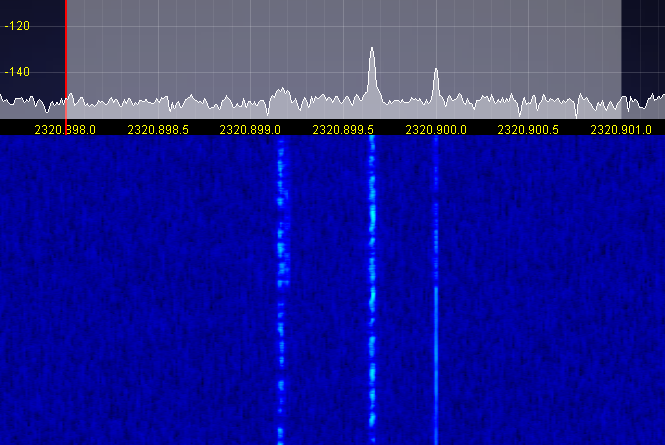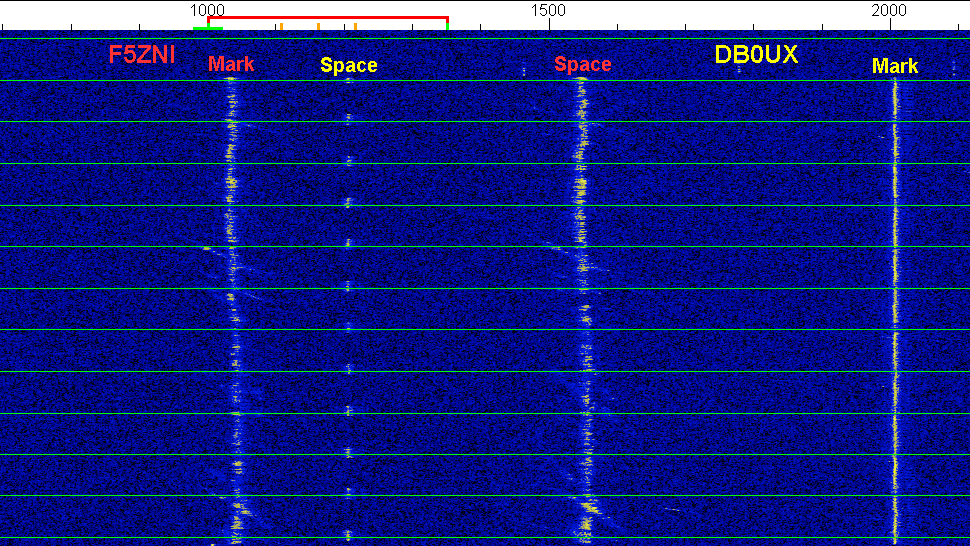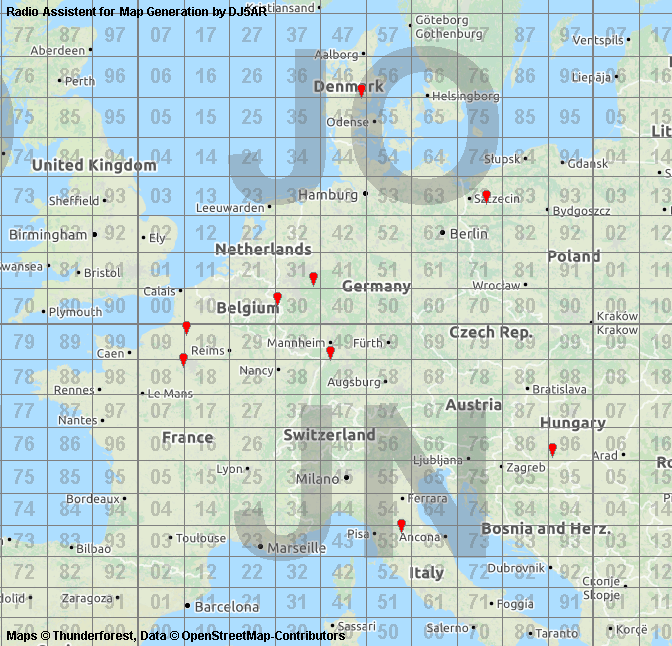August 31st, 2023

At least the results of the IARU Region 1 HAMChallenge have been announced. So Mathias, DH4FAJ and I are happy to be the winner of Challenge#2 with our idea about SPB144, a Special Beacon Project on 144 MHz.

August 31st, 2023

At least the results of the IARU Region 1 HAMChallenge have been announced. So Mathias, DH4FAJ and I are happy to be the winner of Challenge#2 with our idea about SPB144, a Special Beacon Project on 144 MHz.
February 13th, 2022
Today Thomas,DC7YS, took me on a sight seeing tour to the Teufelsberg, a former US military facility and then straight through President electing Berlin to his beacon location in the east of Berlin.







November 8th, 2021
A post by F6HTJ on Facebook informed about the new french beacon F1ZUY on 1296.980 in JN19BQ.

Despite the dish is in the lower parking position at present, I turned it towards France and gave it a little elevation of 4 degrees. Very soon the first refections on airplanes could be seen 300 Hz below the given frequency. The distance to the beacon is 440 km.

The crossing of RYR70SX was strong enought to copy first fragments of the callsign. The beacon is transmitting in A1A with 5 W into a big wheel. Nearly every passenger or freight aircraft, crossing the path, causes reflections.
I am usually happy about every beacon, going on air. As there are many beacons in Europe, the selection of the frequency and its coordination is essential. As many national regualtors grant licenses for a fixed frequency only, a frequency coordination has to be done, before the beacon can go on air. F1ZUY is an example for a beacon that can be heard in a distance of several hundreds of km under normal propagation conditions. Tropospheric ducting can extend the distance to more than 1000 km, probably interfering with other beacons on the same frequency “far” away. So F1ZUY is also a bad example for the lack of coordination by the IARU R1 Beacon Coordinator. It doesn´t matter, whether the keeper didn´t know about the need of beacon coordination or just ignored it. As soon, as LA9SHF will go on air on it´s coordinated frequency of 1296.980 MHz, interference will occur in cases of tropospheric ducting over the North Sea, which happens quite often. Bad luck for beacon observers in Belgium, the Netherlands and Denmark.

So I appeal to all beacon keepers: Please contact the IARU R1 Beacon Coordinator before setting up a beacon or applying for a license!
May 7th, 2020
Yesterday I added a logarithmic periodic antenna for the range 28 to 150 MHz to my little antenna farm. So I am QRV now on the amateur bands from the highest DC band 28 MHz up to 2400 MHz.

Recently I got an IC-7300 with extended frequency range to cover the 50 MHz and 70 MHz, as well as the new Irish bands 80 MHz and 60 MHz.
So I am looking forward to have some cross band QSOs to Ireland soon!
I took down the 3 cm dish for some work on the rig. And I know, the 70 cm yagi is much too close to the new antenna, but I have been too lazy to dismount it.
Addendum May 18th, 2020

First PI4 decodes of EI1KNH in IO63VE on 40 MHz.
January 1st, 2020
I got up quite early today and decided to check the beacons on 23 cm. When beaming to LA1UHG, there was a noticeable signal in F1 about 1 kHz above its frequency. It was easy to read it as DB0LB from the back of the dish. But it seemed, there was another faint signal right beside the spacing carrier. With the help of my SDR radio I could set very narrow filters and after a while of listening, I identified it as LA1UHG, JO59FB, 1028 km. Wow!
But the signal faded out more and more and at least it disappeared.

Later this morning, the dish still pointing north, I heard Kurt, OE5XBL, chatting in SSB with Rudi, OE5VRL/5, both with very strong signals on 23 cm. Expecting a huge signal, I turned the antenna to Kurt, but there was no significant increase in signal strength. I called in and the three of us were talking about the conditions and to meet for a beer at the GHz convention in Dorsten next February, when Kurt was called by Dave, G4RQI. I had tried with him earlier without any success, and so, to be honest, I was a little annoyed by this. Even, when turning the dish to the UK, I couldn´t copy anything of Dave’s transmissions, while he was working Kurt and Rudi. These were enough indications, that the inversion was at a too high altitude for me, to enter it. So I went for a long walk with my XYL in the nearby vineyards.

In the evening I performed another beacon check. It was funny to see beacons, the dish was pointing to, as well as others from the back of the dish

Turning the dish, confirmed the experience I had in the the morning: Pointing southeast I saw DB0VC, JO54IF, next to DB0AAT, JN67HU. Turning the dish towards Kiel in the north, the signal of DB0VC increased just a little. Maybe, it has been reflected by a mountain range about 50 km southeast of me.

December 29th, 2019
By performing my daily beacon check, I noticed a weak keyed carrier in between the spacing of the F1 signal of DB0UX on 2320.900 MHz. I assumed to see F6DWG/B, which I monitored around the .900 before. But it didn´t take long to find out, that the real signal (mark) was the lower carrier and after a while I learned, it was F5ZNI using reverse F1 keying. Later in the evening the signal increased due to good tropo conditions, as can be seen in the pictures. F5ZNI is the 34th beacon I received in the 13 cm (S) Band

I am always happy about new beacons, but this case is an example, why beacon coordination and using standards is most important. First of all, reverse F1 keying is always bad, as you are used to listen to the upper carrier of the signal. In case there is an unkeyed carrier in between the text, you can easily identify the mark, where to listen. But if there is text keyed nearly all the time, as F5ZNI does, it is rather time consuming until the mark is identified.

The DB0UX signal was strong and the frequency is locked to a reference, while F5ZNI is drifting a little. So it was obvious, that there was a second signal in place. If the french beacon would have been locked to 2320.900 MHz too and would use the standard A1 or F1 keying, there would have been no chance for me to monitor or even to take notice of it.
An excerpt from BEACONSPOT.UK shows the situation on 2320.900 MHz:
| Beacon | Nominal Frequency | Locator | Last Spotted | Last Frequency | Status |
|---|---|---|---|---|---|
| F6DWG | 2320.900 | JN19BQ | 2019-05-31 | 2320.898 | Dead/lost |
| HG3BUC | 2320.900 | JN96CC | 2019-10-11 | 2320.897 | Operational |
| OZ5SHF | 2320.900 | JO45VX | 2019-08-24 | 2320.900 | Operational on spot date |
| DB0MJ | 2320.900 | JO31UB | 2019-12-29 | 2320.905 | Operational |
| ON0TB | 2320.900 | JO30BM | 2019-09-20 | 2320.897 | Dead/lost |
| DB0UX | 2320.900 | JN48FX | 2019-12-29 | 2320.900 | Operational on spot date |
| F1ZCC | 2320.900 | JN08XS | Uncertain - new spot required | ||
| SR1SHS | 2320.900 | JO73PG | 2019-12-30 | 2320.900 | Operational |
| IQ5FI | 2320.903 | JN53SR | 2019-12-28 | 2320.901 | Operational |
| F5ZNI | 2320.904 | JN19BQ | 2019-12-30 | 2320.899 | Operational on spot date |

So I am urging all beacon keepers to make use of the service provided by the
IARU R1 VHF/UHF/MW Beacon Coordinator. When designing a beacon, please respect chapter 11 “Beacon Requirements” in the IARU-R1 VHF Handbook.
December 17th, 2019
As the beacon keeper Thomas, DL4EAU, wrote me, the DB0XY beacons in JO51EU are back on air. The frequencies are 1296.912, 2320.912 and 10368.912 MHz. All are locked to a GPS reference now.


June 7th, 2019

When looking for EA2TZ/B during a beacon check a couple of days ago, I mentioned a signal with strong doppler shift about a khz below. As I like the challenge to identify new beacons, I started monitoring it. It became a kind of a nightmare, trying to to catch the beacons callsign. It seems to be very chatty, transmitting a whole bunch of unuseful text. despite the fact I got a lot of good quality fragments via aircraft scatter, it took me hours to identify it as F1ZBK. At least I am pretty sure it is, as there is a second callsign in the end of the text: F1DND, maybe it´s the keepers call.
The text decoded so far is:
—— beacon f1zbk jn38bp nancy … 854 khz … 5 watt … f1dnd … orange KA … ——-
Where the “…” represent gaps and KA is the prosign for “Attention” or “New Message” (not to be used at the end of a message, like AR).
There are many beacons running in bad modes like reversed F2A or keying the subcarrier of F2A, but transmitting such a lot of stuff is worse.
It would be a great advantage, if all beacon keepers will respect the beacon requirements as published in the VHF Handbook of IARU R1.
February 4th, 2019
Jan, PA3FXB, of the CAMRAS team at the radio telescope in Dwingeloo was so kind, to send me some data about occultations of Longjiang-2 or DSLWP-B by the moon. So I monitored the beacon on 2275.22 MHz and saw the signal disappearing, as soon as the moon was covering the probe at 11:06:50 CET.

 As OK0EA was audible this morning on 23 and 13 cm I had a look for other, more distant beacons in OK. After noticing a very short and weak signal on 2320.9085 MHz, I monitored the frequency over a couple of hours and saw many doppler shifted traces, typical for aircraft scatter. Very soon I copied “…9DP…”, when a B777 crossed the path and was sure to see OK0ER in JN99DP in the waterfall diagram. At least 4 Airbuses A380 crossed the path one after the other, giving nice reflections.
As OK0EA was audible this morning on 23 and 13 cm I had a look for other, more distant beacons in OK. After noticing a very short and weak signal on 2320.9085 MHz, I monitored the frequency over a couple of hours and saw many doppler shifted traces, typical for aircraft scatter. Very soon I copied “…9DP…”, when a B777 crossed the path and was sure to see OK0ER in JN99DP in the waterfall diagram. At least 4 Airbuses A380 crossed the path one after the other, giving nice reflections.
 OK0ER transmits 1.5 W into a slot antenna in 675 m asl. The distance is 722 km.
OK0ER transmits 1.5 W into a slot antenna in 675 m asl. The distance is 722 km.